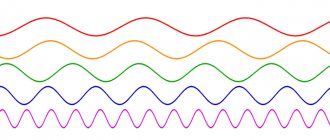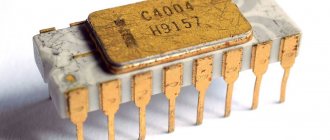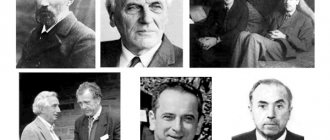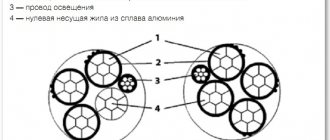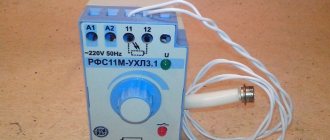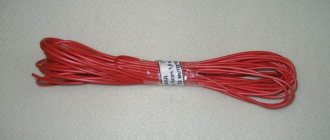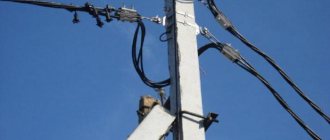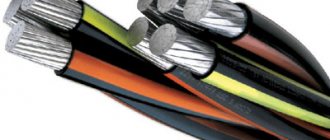ELECTROMAGNETIC RADIATION,
electromagnetic waves excited by various emitting objects - charged particles, atoms, molecules, antennas, etc. Depending on the wavelength, gamma radiation, X-rays, ultraviolet radiation, visible light, infrared radiation, radio waves and low-frequency electromagnetic oscillations are distinguished.
Also on topic:
LIGHT
It may seem surprising that outwardly such different physical phenomena have a common basis. Indeed, what do a piece of radioactive substance, an X-ray tube, a mercury discharge lamp, a flashlight bulb, a warm stove, a radio broadcast station, and an alternator connected to a power line have in common? As, indeed, between photographic film, the eye, a thermocouple, a television antenna and a radio receiver. However, the first list consists of sources, and the second - of receivers of electromagnetic radiation. The effects of different types of radiation on the human body are also different: gamma and X-ray radiation penetrate it, causing tissue damage, visible light causes a visual sensation in the eye, infrared radiation, falling on the human body, heats it, and radio waves and low-frequency electromagnetic vibrations affect the human body and are not felt at all. Despite these obvious differences, all these types of radiation are essentially different sides of the same phenomenon.
The interaction between the source and the receiver formally consists in the fact that with any change in the source, for example when it is turned on, some change is observed in the receiver. This change does not occur immediately, but after some time, and is quantitatively consistent with the idea that something moves from the source to the receiver at a very high speed. Complex mathematical theory and a huge variety of experimental data show that the electromagnetic interaction between a source and a receiver separated by a vacuum or rarefied gas can be represented in the form of waves propagating from the source to the receiver at the speed of light with
.
Also on topic:
X-RAYS
The speed of propagation in free space is the same for all types of electromagnetic waves, from gamma rays to low-frequency waves. But the number of oscillations per unit time (i.e. frequency f
) varies over a very wide range: from several vibrations per second for electromagnetic waves in the low-frequency range to 1020 vibrations per second in the case of X-ray and gamma radiation.
Since the wavelength (i.e., the distance between adjacent wave humps; Fig. 1) is given by the expression l = c
/
f
, it also varies widely - from several thousand kilometers for low-frequency oscillations to 10–14 m for X-ray and gamma-ray radiation. This is why the interaction of electromagnetic waves with matter is so different in different parts of their spectrum. And yet all these waves are related to each other, just as water ripples, waves on the surface of a pond and stormy ocean waves are related, which also have different effects on objects encountered along their path. Electromagnetic waves differ significantly from water waves and from sound in that they can be transmitted from a source to a receiver through a vacuum or interstellar space. For example, X-rays generated in a vacuum tube affect photographic film located far away from it, while the sound of a bell located under a hood cannot be heard if the air is pumped out from under the hood. The eye perceives rays of visible light coming from the Sun, and an antenna located on Earth perceives radio signals from a spacecraft millions of kilometers away. Thus, no material medium, such as water or air, is required for the propagation of electromagnetic waves.
Sources of electromagnetic radiation.
Despite physical differences, in all sources of electromagnetic radiation, be it a radioactive substance, an incandescent lamp or a television transmitter, this radiation is excited by accelerating electrical charges. There are two main types of sources. In “microscopic” sources, charged particles jump from one energy level to another within atoms or molecules. Emitters of this type emit gamma, x-ray, ultraviolet, visible and infrared, and in some cases even longer wavelength radiation (an example of the latter is the line in the spectrum of hydrogen corresponding to a wavelength of 21 cm, which plays an important role in radio astronomy). Sources of the second type can be called macroscopic. In them, free electrons of conductors perform synchronous periodic oscillations. The electrical system can have a wide variety of configurations and sizes. Systems of this type generate radiation in the range from millimeter waves to the longest waves (in power lines).
Gamma rays are emitted spontaneously when the nuclei of radioactive substances such as radium decay. In this case, complex processes of changes in the structure of the nucleus occur, associated with the movement of charges. Generated frequency f
is determined by the difference between the energies
E1
and
E2
of two states of the nucleus:
f =
(
E
1 –
E
2)/
h
, where
h
is Planck’s constant.
See also
CONSTANT BAR.
X-ray radiation occurs when the surface of a metal anode (anti-cathode) is bombarded in a vacuum by electrons with high speeds. Rapidly slowing down in the anode material, these electrons emit the so-called bremsstrahlung radiation, which has a continuous spectrum, and the restructuring of the internal structure of the anode atoms that occurs as a result of electron bombardment, as a result of which the atomic electrons pass into a state with lower energy, is accompanied by the emission of the so-called characteristic radiation, frequency which are determined by the anode material.
The same electronic transitions in an atom produce ultraviolet and visible light radiation. As for infrared radiation, it is usually the result of changes that have little effect on the electronic structure and are associated primarily with changes in the amplitude of vibrations and the angular momentum of the molecule.
Generators of electrical oscillations have an “oscillatory circuit” of one type or another, in which electrons perform forced oscillations with a frequency depending on its design and size. The highest frequencies, corresponding to millimeter and centimeter waves, are generated by klystrons and magnetrons - electric vacuum devices with metal volumetric resonators, oscillations in which are excited by electron currents. In lower frequency generators, the oscillating circuit consists of an inductor (inductance L
) and a capacitor (capacitance
C
) and is excited by a tube or transistor circuit. The natural frequency of such a circuit, which is close to resonant at low attenuation, is given by the expression.
Very low frequency alternating fields used to transmit electrical energy are created by electrical machine current generators in which rotors carrying wire windings rotate between the poles of magnets.
Maxwell's theory, ether and electromagnetic interaction.
When an ocean liner passes at some distance from a fishing boat in calm weather, after some time the boat begins to sway violently on the waves. The reason for this is clear to everyone: from the bow of the liner, a wave runs along the surface of the water in the form of a sequence of humps and depressions, which reaches the fishing boat.
When, with the help of a special generator, oscillations of electric charge are excited in an antenna installed on an artificial Earth satellite and directed towards the Earth, an electric current is excited in the receiving antenna on Earth (also after some time). How is interaction transmitted from source to receiver if there is no material environment between them? And if the signal arriving at the receiver can be represented as some kind of incident wave, then what kind of wave is it that can propagate in a vacuum, and how can humps and depressions appear where there is nothing?
Scientists have been thinking about these questions as applied to visible light propagating from the Sun to the observer’s eye for a long time. Throughout most of the 19th century. physicists such as O. Fresnel, I. Fraunhofer, F. Neumann tried to find the answer in the fact that space is not actually empty, but is filled with a certain medium (“luminiferous ether”), endowed with the properties of an elastic solid. Although this hypothesis helped to explain some phenomena in a vacuum, it led to insurmountable difficulties in the problem of the passage of light through the boundary of two media, for example, air and glass. This prompted the Irish physicist J. McCullagh to discard the idea of elastic ether. In 1839, he proposed a new theory, which postulated the existence of a medium with properties different from all known materials. Such a medium does not resist compression and shear, but resists rotation. Because of these strange properties, McCullagh's model of the ether did not initially attract much interest. However, in 1847 Kelvin demonstrated the existence of an analogy between electrical phenomena and mechanical elasticity. Based on this, as well as from M. Faraday’s ideas about the lines of force of electric and magnetic fields, J. Maxwell proposed a theory of electrical phenomena, which, in his words, “denies action at a distance and attributes electrical action to stresses and pressures in some all-pervasive medium, moreover, these voltages are the same as those with which engineers deal, and the medium is precisely the medium in which light is supposed to propagate.” In 1864, Maxwell formulated a system of equations covering all electromagnetic phenomena. It is noteworthy that his theory was in many ways reminiscent of the theory proposed a quarter of a century earlier by McCullagh. Maxwell's equations were so comprehensive that the laws of Coulomb, Ampere, and electromagnetic induction were derived from them and the conclusion was drawn that the speed of propagation of electromagnetic phenomena coincides with the speed of light.
After Maxwell's equations were given a simpler form (thanks mainly to O. Heaviside and G. Hertz), field equations became the core of electromagnetic theory. Although these equations themselves did not require a Maxwellian interpretation based on ideas about stresses and pressures in the ether, such an interpretation was universally accepted. The undoubted success of the equations in predicting and explaining various electromagnetic phenomena was taken as a confirmation of the validity not only of the equations, but also of the mechanistic model on the basis of which they were derived and interpreted, although this model was completely insignificant for the mathematical theory. Faraday field lines and current tubes, along with deformations and displacements, became essential attributes of the ether. Energy was considered as stored in a tense environment, and its flow was presented by G. Poynting in 1884 as a vector, which now bears his name. In 1887, Hertz experimentally demonstrated the existence of electromagnetic waves. In a series of brilliant experiments, he measured their speed of propagation and showed that they could be reflected, refracted and polarized. In 1896, G. Marconi received a patent for radio communications.
In continental Europe, independently of Maxwell, the theory of long-range action developed - a completely different approach to the problem of electromagnetic interaction. Maxwell wrote on this subject: “According to the theory of electricity, which is making great progress in Germany, two charged particles directly act on each other at a distance with a force, which, according to Weber, depends on their relative speed and acts, according to a theory based on the ideas Gauss and developed by Riemann, Lorentz and Neumann, not instantly, but after some time, depending on the distance. The power of this theory, which explains any kind of electrical phenomena to such outstanding people, can only be truly appreciated by studying it.” The theory that Maxwell spoke about was most fully developed by the Danish physicist L. Lorentz with the help of scalar and vector retarded potentials, almost the same as in modern theory. Maxwell rejected the idea of delayed action at a distance, be it potentials or forces. “These physical hypotheses are completely alien to my ideas about the nature of things,” he wrote. However, Riemann and Lorentz's theory was mathematically identical to his, and he eventually agreed that the long-range theory had better evidence. In his Treatise on Electricity and Magnetism
(
Treatise on Electricity and Magnetism
, 1873) he wrote: “It should not be forgotten that we have taken but one step in the theory of the action of the medium. We suggested that she was in a state of tension, but we did not explain at all what this tension was and how it was maintained.”
In 1895, the Dutch physicist H. Lorentz combined the early limited theories of interaction between stationary charges and currents, which anticipated the theory of retarded potentials of L. Lorentz and were created mainly by Weber, with the general theory of Maxwell. H. Lorentz considered matter as containing electric charges, which, interacting with each other in various ways, produce all known electromagnetic phenomena. Instead of accepting the concept of delayed action at a distance, described by the delayed Riemann and L. Lorentz potentials, he proceeded from the assumption that the movement of charges creates an electromagnetic field
, capable of propagating through the ether and transferring momentum and energy from one system of charges to another. But is the existence of a medium such as ether necessary for the propagation of an electromagnetic field in the form of an electromagnetic wave? Numerous experiments designed to confirm the existence of the ether, including the “ether entrainment” experiment, gave negative results. Moreover, the hypothesis of the existence of the ether turned out to be in conflict with the theory of relativity and with the position of the constancy of the speed of light. The conclusion can be illustrated by the words of A. Einstein: “If the ether is not characterized by any specific state of motion, then it hardly makes sense to introduce it as a certain entity of a special kind along with space.”
INFOFIZ
In the world around us there are objects that a person does not perceive with the help of his senses. To measure the characteristics of these objects, a person can only use special technical devices. Such objects are electric and magnetic fields, electromagnetic waves
.
The existence of electromagnetic waves was theoretically predicted by the great English physicist James Maxwell in 1864 .
Having studied the phenomenon of electromagnetic induction, Faraday
came to the conclusion that the vortex electric field arises when
the magnetic field
. A time-varying magnetic field can be created at a given point in space by moving a magnet towards it or changing the current strength in a wire located next to this point.
In 1864 Maxwell
analyzed all the laws of electrodynamics known at that time and made an attempt to apply them to time-varying electric and magnetic fields. He drew attention to the asymmetry of the relationship between electrical and magnetic phenomena. Maxwell introduced the concept of a vortex electric field into physics and proposed a new interpretation of the law of electromagnetic induction, discovered by Faraday in 1831:
Any change in the magnetic field generates a vortex electric field in the surrounding space, the lines of force of which are closed.
An alternating magnetic field generates an electric field with closed lines of force (tension lines cover magnetic induction lines. The faster the magnetic induction changes, the greater the electric field strength. As magnetic induction increases, the direction of the intensity forms a left screw
with the direction of the magnetic induction vector.
Maxwell also hypothesized the existence of the reverse process. He admitted that an alternating electric field, in turn, generates a magnetic field. In all cases where an electric field changes over time, it generates a magnetic field
.
The lines of magnetic induction of this field cover the lines of electric field strength. But only when the electric field strength increases, the direction of the induction vector of the resulting magnetic field forms a right
screw with the direction of the tension vector.
So, a time-varying electric field generates a magnetic field in the surrounding space.
Maxwell's hypothesis was only a theoretical assumption that did not have experimental confirmation, but on its basis Maxwell managed to write down a consistent system of equations describing the mutual transformations of electric and magnetic fields, that is, the system of equations of the electromagnetic field
(Maxwell's equations).
After the discovery of the relationship between electric and magnetic fields, it became clear that these fields do not exist separately, independently of one another
.
It is impossible to create an alternating magnetic field without simultaneously creating an electric field in space. Conversely, an alternating electric field cannot exist without a magnetic field. Alternating electric and magnetic fields exist simultaneously and form a single electromagnetic field
.
An electromagnetic field
is a special form of matter - a combination of electric and magnetic fields - with the help of which electromagnetic interaction is carried out.
Materiality of the electromagnetic field
:
- It can be registered.
- It exists regardless of our will and desire.
- Has a high but finite speed.
While developing the theory of the electromagnetic field, D. Maxwell in the 60s of the 19th century theoretically substantiated the possibility of the existence of electromagnetic waves and even calculated the speed of their propagation. It coincided with the speed of light v=c=3·108m/s. This gave Maxwell reason to conclude: light is a type of electromagnetic wave.
Around a stationary charge there is only an electric field. An electromagnetic field appears around a charge moving at a constant speed. With the accelerated movement of a charge, an electromagnetic wave is emitted, which propagates in space at a finite speed.
An electromagnetic wave is an electromagnetic field that varies over time and propagates in space .
Electromagnetic wave is transverse
– vectors of tension E and magnetic induction B are perpendicular to each other and lie in a plane perpendicular to the direction of wave propagation.
In an electromagnetic wave, mutual transformations of electric and magnetic fields occur. These processes occur simultaneously, and the electric and magnetic fields act as equal “partners”. Therefore, the volumetric densities of electric and magnetic energy are equal to each other: w
e =
w
m.
Electromagnetic waves propagate in matter at a finite speed.
Velocity of electromagnetic waves in vacuum v=s=2.99792458·108m/s=3·108m/s
The main condition for the occurrence of an electromagnetic wave
is the accelerated movement of electric charges.
Maxwell's conclusions were not recognized by all physicists - Maxwell's contemporaries. Experimental confirmation of the existence of electromagnetic waves was required. Maxwell was deeply convinced of the reality of electromagnetic waves, but he did not live to see their experimental discovery. Only 10 years after his death (about 15 years after the creation of his theory), electromagnetic waves were experimentally obtained in 1888 by the German physicist Heinrich Hertz.
An electromagnetic wave is formed due to the mutual connection of alternating electric and magnetic fields. To generate intense electromagnetic waves, it is necessary to create electromagnetic oscillations of a sufficiently high frequency.
High frequency oscillations can be obtained using an oscillating circuit.
The oscillation frequency will be greater, the lower the inductance L and capacitance C of the circuit
a Hertz vibrator, to produce electromagnetic waves.
.
This device is an open oscillatory circuit
. An ordinary oscillatory circuit, such as the one shown in the figure (it is called closed), is not suitable for emitting electromagnetic waves. The fact is that its alternating electric field is concentrated mainly in a very small region of space between the plates of the capacitor, and the magnetic field is concentrated inside the coil.
The area in which an alternating electric field is created increases if the capacitor plates are moved apart. The capacity decreases. Simultaneous reduction of the plate area will further reduce the capacity. Reducing the capacitance will increase the natural frequency of this oscillatory circuit.
To increase the frequency even more, you need to replace the coil with a straight wire without turns. The inductance of the straight wire is much less than the inductance of the coil. Continuing to move the plates apart and simultaneously reducing their sizes, we will arrive at an open oscillatory circuit. It's just a straight wire
.
To excite oscillations in such a circuit, you need to cut the wire in the middle so that a small air gap remains, called a spark gap
. Thanks to this gap, it is possible to charge both conductors to a high potential difference.
When sufficiently large opposite charges were imparted to the balls, an electrical discharge occurred between them and free electrical oscillations arose in the electrical circuit. Electromagnetic waves were recorded by Hertz using a receiving vibrator, which was the same device as the emitting vibrator. Under the influence of an alternating electric field of an electromagnetic wave, current oscillations are excited in the receiving vibrator. If the natural frequency of the receiving vibrator coincides with the frequency of the electromagnetic wave, resonance is observed and oscillations in the receiving vibrator occur with a large amplitude. Hertz discovered them by observing sparks in a very small gap between the conductors of the receiving vibrator.
Hertz not only experimentally proved the existence of electromagnetic waves, but for the first time began to study their properties - absorption and refraction in different media, reflection from metal surfaces, etc. He was able to experimentally measure the wavelength and speed of propagation of electromagnetic waves, which turned out to be equal to the speed of light .
Wave properties
- Reflection.
- Refraction.
- Interference.
- Diffraction.
- Polarization.
- Pressure on matter
From Maxwell's theory it followed that electromagnetic waves should exert pressure on an absorbing or reflecting body.
The pressure of electromagnetic radiation
is explained by the fact that under the influence of the electric field of the wave, weak currents arise in the substance, that is, the ordered movement of charged particles. These currents are affected by the Ampere force from the magnetic field of the wave, directed into the thickness of the substance. This force creates the resulting pressure. Usually the pressure of electromagnetic radiation is negligible. For example, the pressure of solar radiation arriving on Earth on an absolutely absorbing surface is approximately 5 μPa. The first experiments to determine the radiation pressure on reflecting and absorbing bodies, which confirmed the conclusion of Maxwell's theory, were carried out by P. N. Lebedev (1900). Lebedev's experiments were of great importance for the approval of Maxwell's electromagnetic theory. - Absorption by the environment.
- Final velocity of propagation in vacuum c.
- Causes the phenomenon of photoelectric effect.
- The speed in the medium decreases
.
Electromagnetic wave energy
Electromagnetic waves carry energy. When waves propagate, a flow of electromagnetic energy arises. If we select area S
oriented perpendicular to the direction of wave propagation, then in a short time Δ
t
energy Δ
W
em will flow through the area, equal to
ΔW _
em = (
w
e +
w
m)υ
S
Δ
t
Hertz's experiments played a decisive role in the proof and recognition of Maxwell's electromagnetic theory. But the German physicist did not see any prospects for their use. After his discovery, Hertz wrote: “Unfortunately, this phenomenon will never be used in practice.” Hertz's experiments interested physicists around the world. The idea of using electromagnetic waves immediately arose among many scientists. Only seven years after Hertz's experiments, electromagnetic waves found application in wireless communications.
In Russia, Alexander Stepanovich Popov, a teacher of officer mine courses in Kronstadt, was one of the first to study the transmission of electromagnetic waves. Starting by reproducing Hertz's experiments, he then found a way to transmit electromagnetic signals over long distances. On May 7, 1895, at a meeting of the Russian Physical-Chemical Society in St. Petersburg, A. S. Popov demonstrated the operation of his device, which was, in fact, the world's first radio receiver. Range - 250 m. Popov was the first to use a coherer and a receiving antenna.
May 7th became the birthday of radio.
In 1899, the range was already 20 km; 1901 - 150 km.
Wireless communication was achieved using electromagnetic waves.
The 21st century Earth, shrouded in a network of telecommunications devices, looks like this thanks to the discovery of electromagnetic waves.
Radio communication is a type of wireless communication that uses radio waves propagated in space as a signal.
The principles of radio communication are far from new. During this time, radio equipment has gone from the first Morse code signal transmitters to satellite communication systems. The radio air was filled with music from radio stations, signals from distant galaxies and our conversations. However, since then the main thing has not changed - radio waves.
The principle of radiotelephone communication.
The principle of radio communication is based on transmitting a signal from a transmitting device containing a transmitter and a transmitting antenna, by moving radio waves in open space, to a receiving device containing a receiving antenna and a radio receiver.
The transmitter microphone, under the influence of sound vibrations, produces a weak low-frequency electric current. This signal enters a low frequency amplifier (LF). The ULF signal enters the modulator. The high frequency generator (HFG) produces continuous high frequency oscillations (HF), which also enter the modulator, where they are amplitude modulated by low frequency oscillations and enter the antenna. The antenna emits electromagnetic waves into the surrounding space, the amplitude of which is also modulated at low frequency. The HHF frequency is the carrier frequency, and it determines the frequency (and wave) of the transmitting station. Harmonic oscillations with a carrier frequency belonging to any radio frequency range are modulated in accordance with the transmitted message. Modulated radio frequency oscillations constitute a radio signal, and modulated electromagnetic waves constitute a radio wave .
Moving freely, radio waves reach the receiving antenna and excite electrical vibrations in it, which then enter the radio receiver. In the receiver antenna, radio waves (in reality there are many transmitters) excite alternating induction emfs of different frequencies. To select the frequency of the desired radio station, an input oscillating circuit is used, which may have a variable capacitor or a coil with variable inductance. In any case, a change in capacitance or inductance leads to a change in the natural frequency of the input circuit and, at the moment when this frequency coincides with the carrier frequency of the radio station, resonance is observed. This effect allows you to highlight the signal of a particular radio station among others. However, the signal remains weak in the fall and is amplified by the high frequency amplifier (UHF) of the receiver. The received radio signal is demodulated after amplification. The detector selects one half of the amplitude-modulated signal, the filter smoothes out the ripples, turning it into a low-frequency signal. The ULF amplifies the low-frequency signal, and the loudspeaker converts the amplified electrical signal into sound vibrations. A signal is released that is similar to the signal with which the oscillations in the radio transmitter were modulated. The signal is converted using an appropriate playback device into a message similar to the original one.
Block diagram of a radio transmitter and radio receiver.
1. Master oscillator
(high frequency generator) produces harmonic oscillations of high HF frequency (carrier frequency more than 100 thousand Hz).
2. Microphone
converts mechanical sound vibrations into electrical vibrations of the same frequency.
3. Modulator
changes (modulates) high-frequency oscillations in frequency or amplitude using electrical oscillations of low LF frequencies.
UHF high and low frequency amplifiers
and
ULF
amplify the power of high-frequency and sound (low-frequency) electrical vibrations.
5. Transmitting antenna
emits modulated electromagnetic waves.
6. Receiving antenna
receives electromagnetic waves. An electromagnetic wave that reaches the receiving antenna induces in it an alternating current of the same frequency at which the transmitter operates.
7. UHF.
8. Detector
selects low-frequency oscillations from modulated high-frequency oscillations.
9. ULF.
10. Speaker
converts electromagnetic vibrations into mechanical sound vibrations.
Amplitude modulation
Changing the amplitude of vibrations of a high (carrier) frequency by vibrations of a low (sound) frequency is called
amplitude modulation
.
To obtain amplitude-modulated electromagnetic oscillations, a transformer coil is connected in series with the oscillating circuit to the transistor generator circuit. Audio frequency voltage is applied to the primary winding of the transformer. An EMF of the same frequency is induced on the secondary winding of the transformer and is added to the constant voltage of the current source. A change in the voltage between the emitter and the collector of the transistor leads to a change in the sound frequency, the amplitude of high-frequency current oscillations in the oscillatory circuit of the generator. As a result, the amplitude of oscillations in the generator circuit will change in time with the change in the voltage of the low-frequency signal on the transistor. When the amplitude of the LF signal changes, the depth of the modulation changes.
Detection (demodulation)
The separation of low-frequency oscillations from modulated high-frequency oscillations is called detection (demodulation).
Detection is carried out by a device containing an element with one-way conductivity: a vacuum or semiconductor diode - a detector.
The current-voltage characteristic of the diode shows that the current in the circuit flows predominantly in one direction, being a pulsating current.
This current is smoothed using a filter.
When a diode passes current, part of it passes through the load, and the other part is branched off to the capacitor.
If the diode is blocked, then the capacitor is partially discharged through the load. Current ripple is reduced.
An audio frequency current flows through the load, and the oscillation shape reproduces the shape of a low-frequency signal.
Radiation and propagation of electromagnetic waves.
Electric charges moving with acceleration and periodically changing currents influence each other with certain forces. The magnitude and direction of these forces depend on such factors as the configuration and size of the region containing the charges and currents, the magnitude and relative direction of the currents, the electrical properties of the given medium, and changes in the concentration of charges and the distribution of source currents. Due to the complexity of the general formulation of the problem, the law of forces cannot be represented in the form of a single formula. The structure called the electromagnetic field, which can be considered a purely mathematical object if desired, is determined by the distribution of currents and charges created by a given source, taking into account boundary conditions determined by the shape of the interaction region and the properties of the material. When we are talking about unlimited space, these conditions are supplemented by a special boundary condition - the radiation condition
. The latter guarantees the “correct” behavior of the field at infinity.
The electromagnetic field is characterized by the electric field strength vector E
and the magnetic induction vector
B
, each of which at any point in space has a certain magnitude and direction.
In Fig. Figure 2 schematically shows an electromagnetic wave with vectors E
and
B
, propagating in the positive direction of the
x
. Electric and magnetic fields are closely interrelated: they are components of a single electromagnetic field, since they transform into each other during Lorentz transformations. A vector field is said to be linearly (plane) polarized if the direction of the vector remains fixed everywhere, and its length changes periodically. If the vector rotates, but its length does not change, then the field is said to have circular polarization; if the length of the vector changes periodically, and it itself rotates, then the field is called elliptically polarized.
The relationship between the electromagnetic field and the oscillating currents and charges that support this field can be illustrated with a relatively simple but very clear example of an antenna such as a half-wave symmetrical vibrator (Fig. 3). If a thin wire, the length of which is half the wavelength of the radiation, is cut in the middle and a high-frequency generator is connected to the cut, then the applied alternating voltage will maintain an approximately sinusoidal current distribution in the vibrator. At time t
= 0, when the current amplitude reaches its maximum value, and the velocity vector of positive charges is directed upward (negative charges are directed downward), at any point of the antenna the charge per unit length is zero.
After the first quarter of the period ( t
=
T
/4), positive charges will be concentrated on the upper half of the antenna, and negative charges on the lower.
In this case, the current is zero (Fig. 3, b
).
At the moment t
=
T
/2, the charge per unit length is zero, and the velocity vector of positive charges is directed downward (Fig. 3,
c
).
Then, by the end of the third quarter, the charges are redistributed (Fig. 3, d
), and at its completion the full period of oscillation ends (
t
=
T
) and everything again looks like in Fig.
3, a
.
In order for a signal (for example, the time-varying current driving a radio speaker) to be transmitted over a distance, the radiation from the transmitter must be modulated
by, for example, changing the amplitude of the current in the transmitting antenna in accordance with the signal, which will entail modulation of the amplitude of oscillations of the electromagnetic field (Fig. 4).
The transmitting antenna is that part of the transmitter where electric charges and currents oscillate, emitting an electromagnetic field into the surrounding space. The antenna can have a wide variety of configurations, depending on what shape of the electromagnetic field needs to be obtained. It can be a single symmetrical vibrator or a system of symmetrical vibrators located at a certain distance from each other and providing the necessary relationship between the amplitudes and phases of the currents. The antenna can be a symmetrical vibrator located in front of a relatively large flat or curved metal surface that acts as a reflector. In the range of centimeter and millimeter waves, an antenna in the form of a horn connected to a metal pipe-waveguide, which plays the role of a transmission line, is especially effective. Currents in the short antenna at the input of the waveguide induce alternating currents on its inner surface. These currents and the associated electromagnetic field propagate along the waveguide to the horn. see also
ANTENNA.
By changing the design of the antenna and its geometry, it is possible to achieve such a ratio of amplitudes and phases of current oscillations in its various parts so that the radiation is amplified in some directions and weakened in others (directional antennas).
At large distances from an antenna of any type, the electromagnetic field has a fairly simple form: at any given point the electric field strength vectors E
and the magnetic field induction
B
oscillates in phase in mutually perpendicular planes, decreasing in inverse proportion to the distance from the source.
In this case, the wave front has the shape of a sphere increasing in size, and the energy flow vector (Poynting vector) is directed outward along its radii. The integral of the Poynting vector over the entire sphere gives the total time-averaged emitted energy. In this case, waves propagating in the radial direction at the speed of light transfer from the source not only oscillations of the vectors E
and
B
, but also the momentum of the field and its energy.
Electromagnetic field
In 1860-1865 one of the greatest physicists of the 19th century, James Clerk Maxwell
created the theory
of the electromagnetic field.
According to Maxwell, the phenomenon of electromagnetic induction is explained as follows. If at a certain point in space the magnetic field changes in time, then an electric field is also formed there. If there is a closed conductor in the field, then the electric field causes an induced current in it. From Maxwell's theory it follows that the reverse process is also possible. If in a certain region of space the electric field changes with time, then a magnetic field is also formed there.
Thus, any change in the magnetic field over time gives rise to a changing electric field, and any change in the electric field over time gives rise to a changing magnetic field. These alternating electric and magnetic fields generating each other form a single electromagnetic field.
Reception of electromagnetic waves and the phenomenon of scattering.
If a conducting cylinder is placed in the zone of an electromagnetic field propagating from a remote source, then the currents induced in it will be proportional to the strength of the electromagnetic field and, in addition, will depend on the orientation of the cylinder relative to the front of the incident wave and on the direction of the electric field strength vector. If the cylinder is in the form of a wire, the diameter of which is small compared to the wavelength, then the induced current will be maximum when the wire is parallel to the vector E
falling wave. If the wire is cut in the middle and a load is connected to the resulting terminals, then energy will be supplied to it, as is the case in the case of a radio receiver. The currents in this wire behave in the same way as the alternating currents in the transmitting antenna, and therefore it also emits a field into the surrounding space (i.e., the incident wave is scattered).
Electromagnetic waves of different ranges and their properties
Electromagnetic waves include:
- Infrared radiation (also called “thermal”). According to the classification of the electromagnetic radiation scale, the region of propagation of infrared radiation is located after radio waves and before visible light. Infrared waves are emitted by all bodies that emit heat. Examples of sources of such radiation are stoves, batteries used for heating based on heat transfer from water, and incandescent lamps. Today, special devices have been developed that allow you to see objects from which heat emanates in complete darkness. Snakes have such natural heat recognition sensors in the eye area. This allows them to track prey and hunt at night. A person uses infrared radiation, for example, to heat buildings, to dry vegetables and wood, in the field of military affairs (for example, night vision devices or thermal imagers), to wirelessly control an audio center or TV and other devices using a remote control.
- Low frequency waves. Characterized by an oscillation frequency of no more than 100 kHz. This range is used to operate electrical devices and motors, for example, a microphone or loudspeaker, telephone networks, as well as in the field of radio broadcasting, film industry, etc. Low-frequency waves differ from those that have a higher oscillation frequency, the actual decrease in propagation speed is proportional to the square root their frequencies. Lodge and Tesla made a significant contribution to the discovery and study of low-frequency waves.
- Radio waves. Hertz's discovery of radio waves in 1886 gave the world the ability to transmit information without using wires. The length of a radio wave affects the nature of its propagation. They, like the frequencies of sound waves, arise due to alternating current (in the process of radio communication, alternating current flows into the receiver - the antenna). High-frequency radio waves contribute to the significant emission of radio waves into the surrounding space, which provides a unique opportunity to transmit information over long distances (radio, television). This kind of microwave radiation is used for communication in space, as well as in everyday life. For example, a microwave oven that emits radio waves has become a good assistant for housewives.
- Visible light. It has a light spectrum from red to violet and is perceived by the human eye, which is the main distinguishing feature. Color emitted at different wavelengths has an electrochemical effect on the human visual perception system, but is not included in the properties of electromagnetic waves in this range.
- Ultraviolet radiation. It is not detected by the human eye and has a wavelength shorter than that of violet light. In small dosages, ultraviolet rays cause a healing effect, promote the production of vitamin D, have a bactericidal effect and have a positive effect on the central nervous system. Excessive saturation of the environment with ultraviolet rays leads to damage to the skin and destruction of the retina, which is why ophthalmologists recommend the use of sunglasses in the summer months. Ultraviolet radiation is used in medicine (ultraviolet rays are used for quartz lamps), to verify the authenticity of banknotes, for entertainment purposes in discos (such lighting makes light-colored materials glow), and also to determine the suitability of food products.
- X-ray radiation. Such waves are invisible to the human eye. They have the amazing property of penetrating through layers of matter, avoiding strong absorption, which is inaccessible to visible light rays. Radiation causes the glow of certain types of crystals and affects photographic film. It is used in the field of medicine to diagnose diseases of internal organs and to treat a certain list of diseases, to check the internal structure of products for defects, as well as welds in equipment.
- Gamma radiation. The shortest wavelength electromagnetic radiation emitted by the nuclei of an atom. Reducing the wavelength leads to changes in quality indicators. Gamma radiation has a penetrating power many times greater than X-rays. It can pass through a concrete wall one meter thick and even through lead barriers several centimeters thick. During the disintegration of substances or unification, the constituent elements of the atom are released, which is called radiation. Such waves are classified as radioactive radiation. When a nuclear warhead explodes, an electromagnetic field is generated for a short time, which is the product of the reaction between gamma rays and neutrons. It also acts as the main element of nuclear weapons, which has a damaging effect, completely blocks or disrupts the operation of radio electronics, wired communications and systems that provide power supply. Also, when a nuclear weapon explodes, a lot of energy is released.
Reflection and refraction of electromagnetic waves.
The transmitting antenna is usually installed high above the ground. If the antenna is located in a dry sandy or rocky area, then the soil behaves as an insulator (dielectric), and the currents induced in it by the antenna are associated with intra-atomic vibrations, since there are no free charge carriers, as in conductors and ionized gases. These microscopic vibrations create a field of electromagnetic waves reflected from the earth's surface above the earth's surface and, in addition, change the direction of propagation of the wave entering the soil. This wave moves at a lower speed and at a smaller angle to the normal than the incident one. This phenomenon is called refraction. If the wave falls on a section of the earth’s surface that, along with dielectric properties, also has conductive properties, then the overall picture for the refracted wave looks much more complicated. As before, the wave changes direction at the interface, but now the field in the ground propagates in such a way that surfaces of equal phases no longer coincide with surfaces of equal amplitudes, as is usually the case with a plane wave. In addition, the amplitude of wave oscillations quickly decays, since conduction electrons give up their energy to atoms during collisions. As a result, the energy of wave oscillations turns into the energy of chaotic thermal motion and is dissipated. Therefore, where the soil conducts electricity, waves cannot penetrate it to great depths. The same applies to sea water, which makes radio communication with submarines difficult.
In the upper layers of the earth's atmosphere there is a layer of ionized gas called the ionosphere. It consists of free electrons and positively charged ions. Under the influence of electromagnetic waves sent from the earth, charged particles of the ionosphere begin to oscillate and emit their own electromagnetic field. Charged ionospheric particles interact with the sent wave in approximately the same way as dielectric particles in the case discussed above. However, the electrons of the ionosphere are not associated with atoms, as in a dielectric. They react to the electric field of the sent wave not instantly, but with some phase shift. As a result, the wave in the ionosphere propagates not at a smaller angle, as in a dielectric, but at a larger angle to the normal than the incident wave sent from the earth, and the phase velocity of the wave in the ionosphere turns out to be greater than the speed of light c
. When the wave falls at a certain critical angle, the angle between the refracted ray and the normal becomes close to a straight line, and with a further increase in the angle of incidence, the radiation is reflected towards the Earth. Obviously, in this case, the electrons of the ionosphere create a field that compensates for the field of the refracted wave in the vertical direction, and the ionosphere acts as a mirror.
Energy and impulse of radiation.
In modern physics, the choice between Maxwell's theory of electromagnetic field and the theory of delayed long-range action is made in favor of Maxwell's theory. As long as we are only interested in the interaction between source and receiver, both theories are equally good. However, the theory of long-range action does not give any answer to the question of where the energy is located that the source has already emitted, but has not yet received by the receiver. According to Maxwell's theory, the source transmits energy to the electromagnetic wave, in which it remains until it is transferred to the receiver that absorbs the wave. At the same time, the law of conservation of energy is observed at each stage.
Thus, electromagnetic waves have energy (as well as momentum), which makes them considered as real as, for example, atoms. Electrons and protons found in the Sun transfer energy to electromagnetic radiation, mainly in the infrared, visible and ultraviolet regions of the spectrum; After about 500 seconds, having reached the Earth, it releases this energy: the temperature rises, photosynthesis occurs in the green leaves of plants, etc. In 1901, P.N. Lebedev experimentally measured the pressure of light, confirming that light has not only energy, but also momentum (and the relationship between them is consistent with Maxwell’s theory).
